Leadership, Management Roles, Theories and Application at M&S
VerifiedAdded on 2020/01/16
|18
|5224
|172
Report
AI Summary
This report provides a comprehensive analysis of leadership and management roles, focusing on their distinctions and applications within the context of Marks & Spencer (M&S). It explores the characteristics of leaders and managers, comparing their orientations and functions. The report delves into various leadership theories, including situational, contingency, and behavioral theories, examining their strengths and weaknesses and how they can be applied in different organizational contexts. Furthermore, it investigates the key approaches to operations and management, emphasizing the importance of operations management in achieving business objectives. The report also assesses the factors within the business environment that impact operational management and decision-making by leaders and managers, providing a holistic view of leadership and management in a business setting. The report is divided into two main tasks, the first focusing on leadership and the second on operations management.
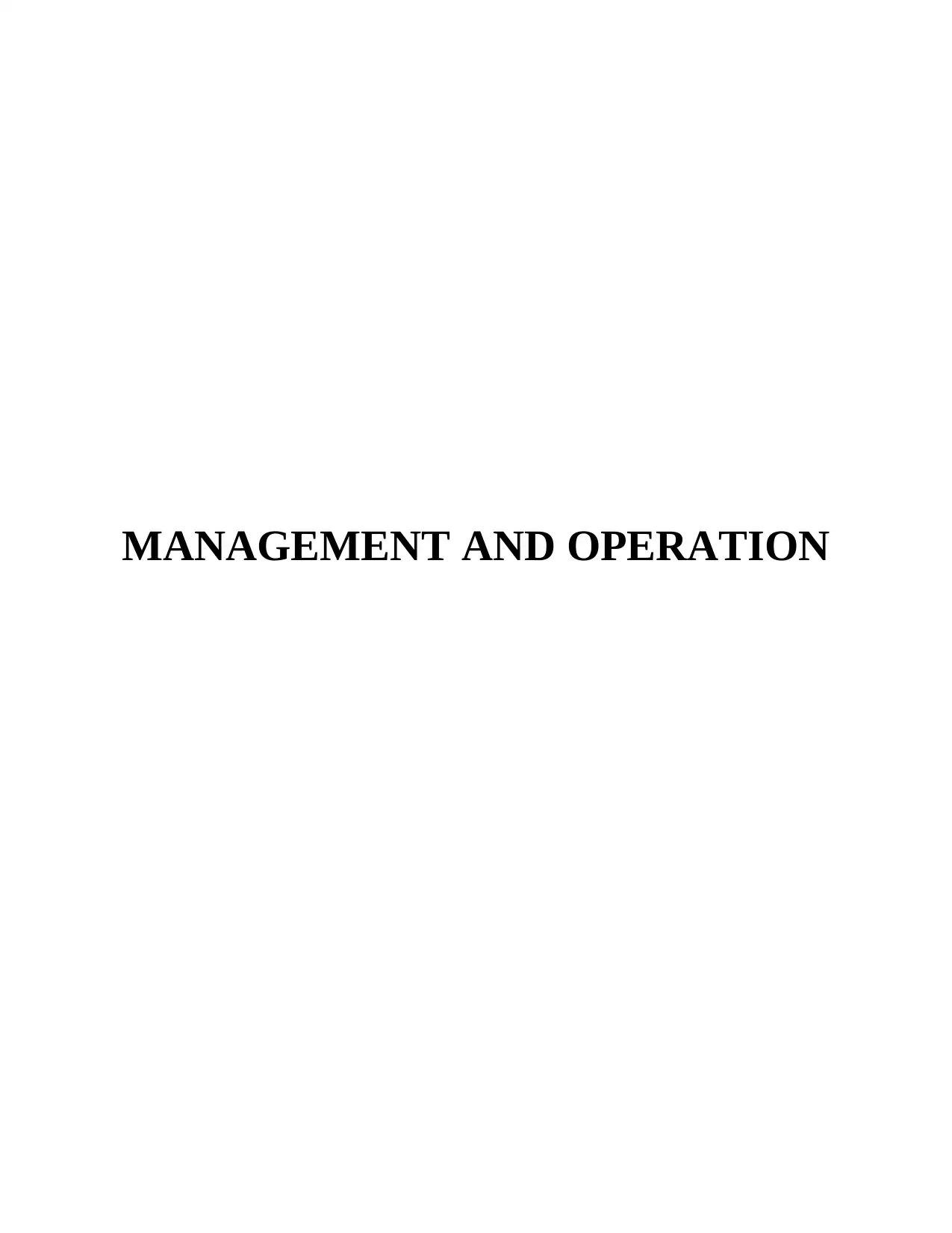
MANAGEMENT AND OPERATION
Paraphrase This Document
Need a fresh take? Get an instant paraphrase of this document with our AI Paraphraser
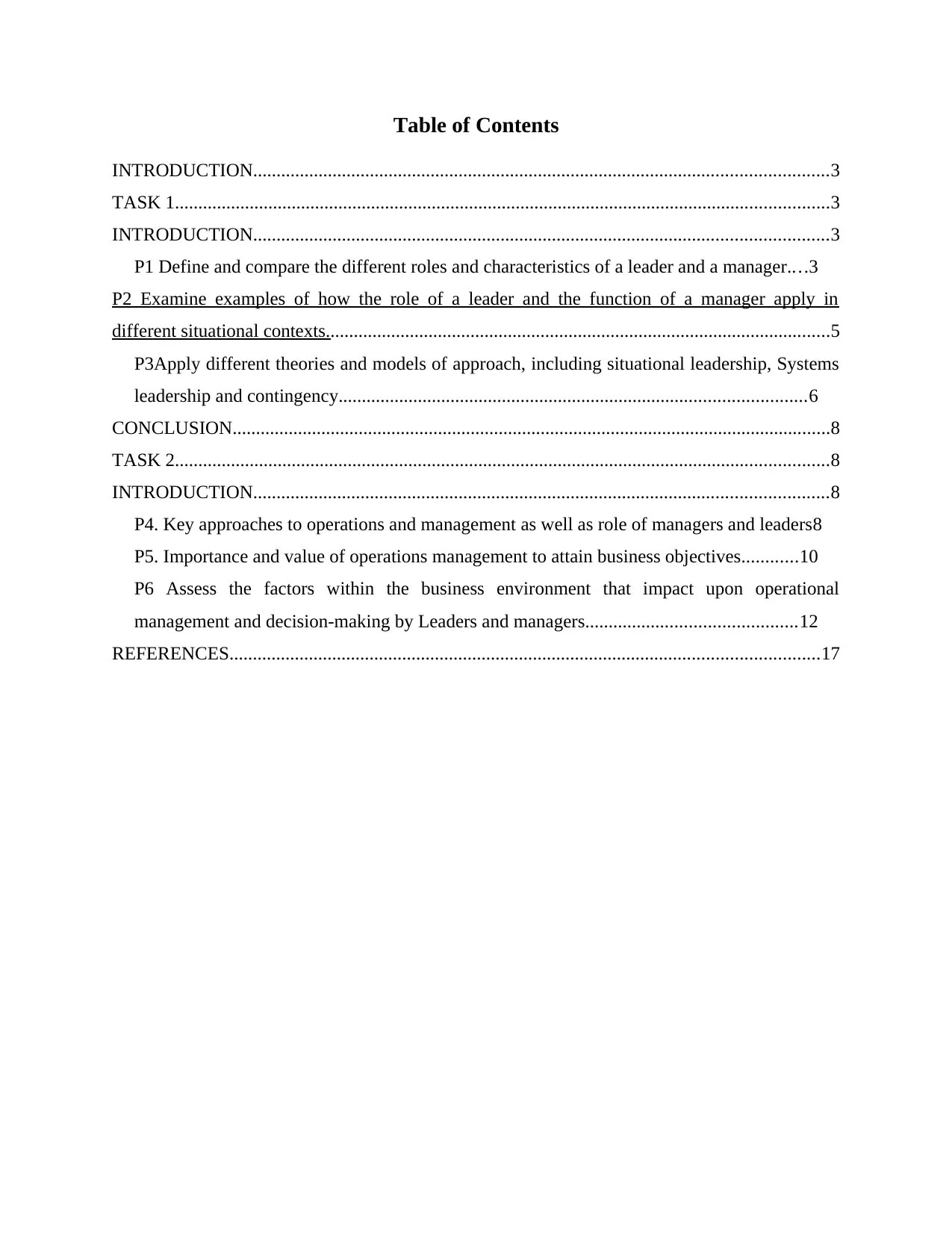
Table of Contents
INTRODUCTION...........................................................................................................................3
TASK 1............................................................................................................................................3
INTRODUCTION...........................................................................................................................3
P1 Define and compare the different roles and characteristics of a leader and a manager....3
P2 Examine examples of how the role of a leader and the function of a manager apply in
different situational contexts............................................................................................................5
P3Apply different theories and models of approach, including situational leadership, Systems
leadership and contingency....................................................................................................6
CONCLUSION................................................................................................................................8
TASK 2............................................................................................................................................8
INTRODUCTION...........................................................................................................................8
P4. Key approaches to operations and management as well as role of managers and leaders8
P5. Importance and value of operations management to attain business objectives............10
P6 Assess the factors within the business environment that impact upon operational
management and decision-making by Leaders and managers.............................................12
REFERENCES..............................................................................................................................17
INTRODUCTION...........................................................................................................................3
TASK 1............................................................................................................................................3
INTRODUCTION...........................................................................................................................3
P1 Define and compare the different roles and characteristics of a leader and a manager....3
P2 Examine examples of how the role of a leader and the function of a manager apply in
different situational contexts............................................................................................................5
P3Apply different theories and models of approach, including situational leadership, Systems
leadership and contingency....................................................................................................6
CONCLUSION................................................................................................................................8
TASK 2............................................................................................................................................8
INTRODUCTION...........................................................................................................................8
P4. Key approaches to operations and management as well as role of managers and leaders8
P5. Importance and value of operations management to attain business objectives............10
P6 Assess the factors within the business environment that impact upon operational
management and decision-making by Leaders and managers.............................................12
REFERENCES..............................................................................................................................17
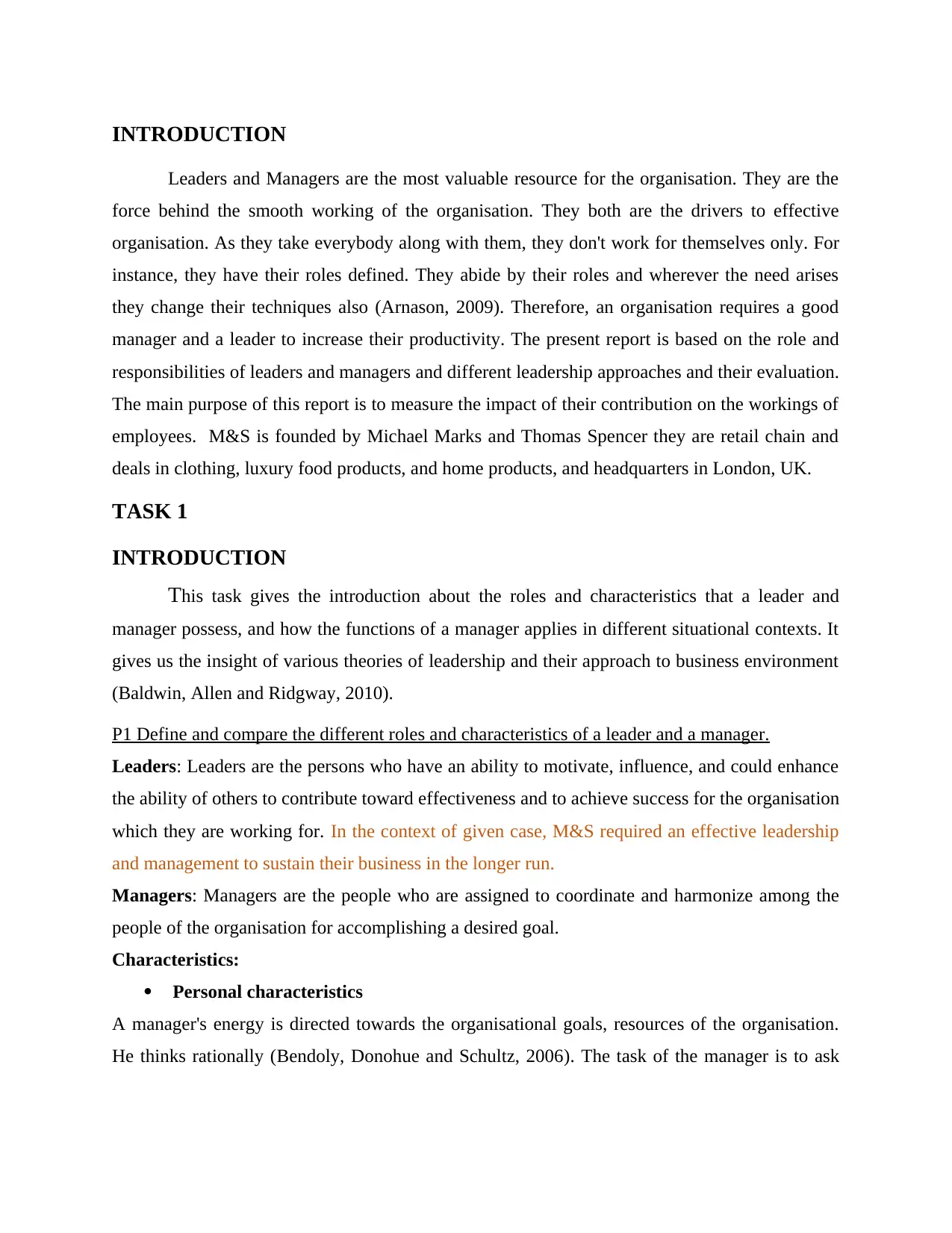
INTRODUCTION
Leaders and Managers are the most valuable resource for the organisation. They are the
force behind the smooth working of the organisation. They both are the drivers to effective
organisation. As they take everybody along with them, they don't work for themselves only. For
instance, they have their roles defined. They abide by their roles and wherever the need arises
they change their techniques also (Arnason, 2009). Therefore, an organisation requires a good
manager and a leader to increase their productivity. The present report is based on the role and
responsibilities of leaders and managers and different leadership approaches and their evaluation.
The main purpose of this report is to measure the impact of their contribution on the workings of
employees. M&S is founded by Michael Marks and Thomas Spencer they are retail chain and
deals in clothing, luxury food products, and home products, and headquarters in London, UK.
TASK 1
INTRODUCTION
This task gives the introduction about the roles and characteristics that a leader and
manager possess, and how the functions of a manager applies in different situational contexts. It
gives us the insight of various theories of leadership and their approach to business environment
(Baldwin, Allen and Ridgway, 2010).
P1 Define and compare the different roles and characteristics of a leader and a manager.
Leaders: Leaders are the persons who have an ability to motivate, influence, and could enhance
the ability of others to contribute toward effectiveness and to achieve success for the organisation
which they are working for. In the context of given case, M&S required an effective leadership
and management to sustain their business in the longer run.
Managers: Managers are the people who are assigned to coordinate and harmonize among the
people of the organisation for accomplishing a desired goal.
Characteristics:
Personal characteristics
A manager's energy is directed towards the organisational goals, resources of the organisation.
He thinks rationally (Bendoly, Donohue and Schultz, 2006). The task of the manager is to ask
Leaders and Managers are the most valuable resource for the organisation. They are the
force behind the smooth working of the organisation. They both are the drivers to effective
organisation. As they take everybody along with them, they don't work for themselves only. For
instance, they have their roles defined. They abide by their roles and wherever the need arises
they change their techniques also (Arnason, 2009). Therefore, an organisation requires a good
manager and a leader to increase their productivity. The present report is based on the role and
responsibilities of leaders and managers and different leadership approaches and their evaluation.
The main purpose of this report is to measure the impact of their contribution on the workings of
employees. M&S is founded by Michael Marks and Thomas Spencer they are retail chain and
deals in clothing, luxury food products, and home products, and headquarters in London, UK.
TASK 1
INTRODUCTION
This task gives the introduction about the roles and characteristics that a leader and
manager possess, and how the functions of a manager applies in different situational contexts. It
gives us the insight of various theories of leadership and their approach to business environment
(Baldwin, Allen and Ridgway, 2010).
P1 Define and compare the different roles and characteristics of a leader and a manager.
Leaders: Leaders are the persons who have an ability to motivate, influence, and could enhance
the ability of others to contribute toward effectiveness and to achieve success for the organisation
which they are working for. In the context of given case, M&S required an effective leadership
and management to sustain their business in the longer run.
Managers: Managers are the people who are assigned to coordinate and harmonize among the
people of the organisation for accomplishing a desired goal.
Characteristics:
Personal characteristics
A manager's energy is directed towards the organisational goals, resources of the organisation.
He thinks rationally (Bendoly, Donohue and Schultz, 2006). The task of the manager is to ask
⊘ This is a preview!⊘
Do you want full access?
Subscribe today to unlock all pages.

Trusted by 1+ million students worldwide
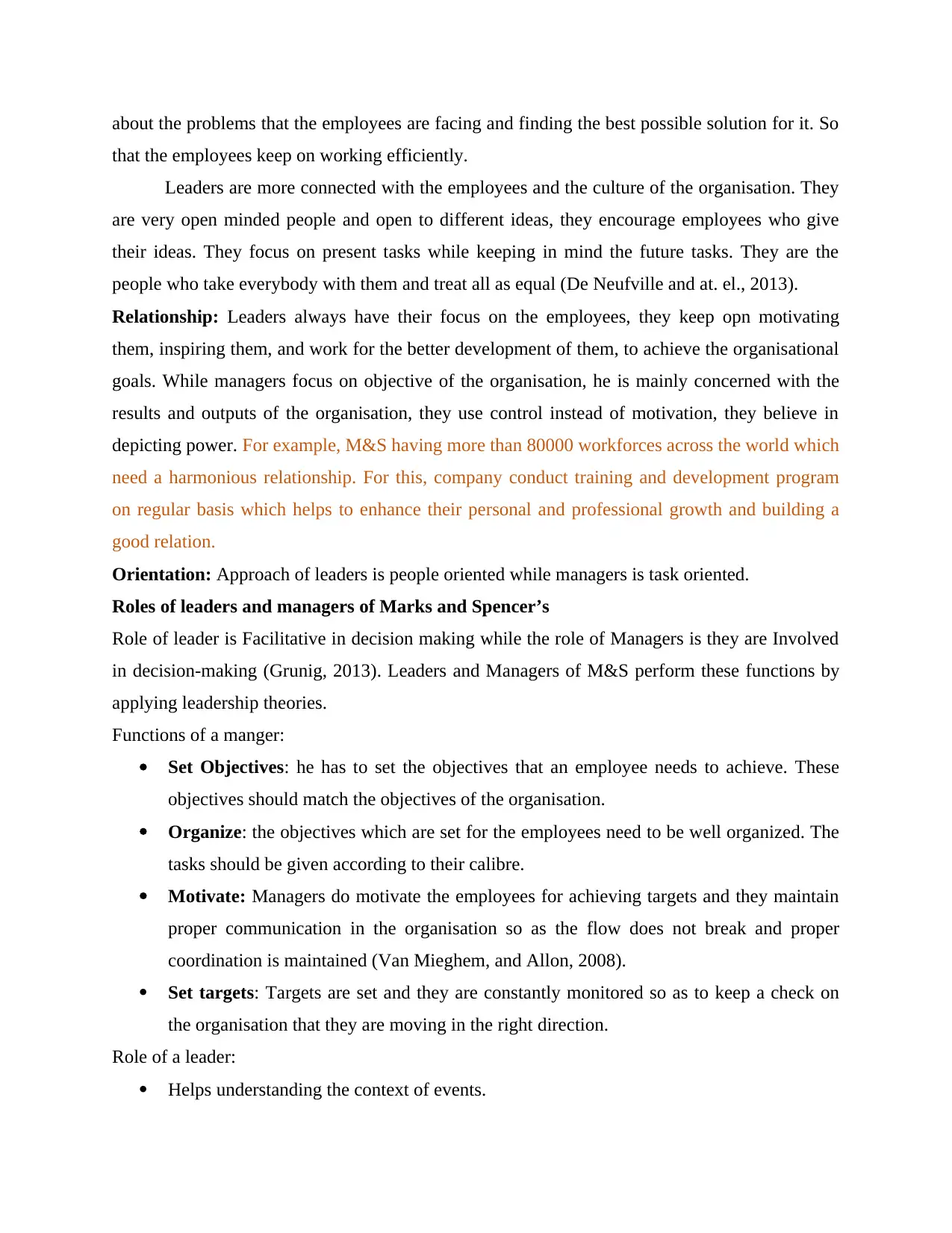
about the problems that the employees are facing and finding the best possible solution for it. So
that the employees keep on working efficiently.
Leaders are more connected with the employees and the culture of the organisation. They
are very open minded people and open to different ideas, they encourage employees who give
their ideas. They focus on present tasks while keeping in mind the future tasks. They are the
people who take everybody with them and treat all as equal (De Neufville and at. el., 2013).
Relationship: Leaders always have their focus on the employees, they keep opn motivating
them, inspiring them, and work for the better development of them, to achieve the organisational
goals. While managers focus on objective of the organisation, he is mainly concerned with the
results and outputs of the organisation, they use control instead of motivation, they believe in
depicting power. For example, M&S having more than 80000 workforces across the world which
need a harmonious relationship. For this, company conduct training and development program
on regular basis which helps to enhance their personal and professional growth and building a
good relation.
Orientation: Approach of leaders is people oriented while managers is task oriented.
Roles of leaders and managers of Marks and Spencer’s
Role of leader is Facilitative in decision making while the role of Managers is they are Involved
in decision-making (Grunig, 2013). Leaders and Managers of M&S perform these functions by
applying leadership theories.
Functions of a manger:
Set Objectives: he has to set the objectives that an employee needs to achieve. These
objectives should match the objectives of the organisation.
Organize: the objectives which are set for the employees need to be well organized. The
tasks should be given according to their calibre.
Motivate: Managers do motivate the employees for achieving targets and they maintain
proper communication in the organisation so as the flow does not break and proper
coordination is maintained (Van Mieghem, and Allon, 2008).
Set targets: Targets are set and they are constantly monitored so as to keep a check on
the organisation that they are moving in the right direction.
Role of a leader:
Helps understanding the context of events.
that the employees keep on working efficiently.
Leaders are more connected with the employees and the culture of the organisation. They
are very open minded people and open to different ideas, they encourage employees who give
their ideas. They focus on present tasks while keeping in mind the future tasks. They are the
people who take everybody with them and treat all as equal (De Neufville and at. el., 2013).
Relationship: Leaders always have their focus on the employees, they keep opn motivating
them, inspiring them, and work for the better development of them, to achieve the organisational
goals. While managers focus on objective of the organisation, he is mainly concerned with the
results and outputs of the organisation, they use control instead of motivation, they believe in
depicting power. For example, M&S having more than 80000 workforces across the world which
need a harmonious relationship. For this, company conduct training and development program
on regular basis which helps to enhance their personal and professional growth and building a
good relation.
Orientation: Approach of leaders is people oriented while managers is task oriented.
Roles of leaders and managers of Marks and Spencer’s
Role of leader is Facilitative in decision making while the role of Managers is they are Involved
in decision-making (Grunig, 2013). Leaders and Managers of M&S perform these functions by
applying leadership theories.
Functions of a manger:
Set Objectives: he has to set the objectives that an employee needs to achieve. These
objectives should match the objectives of the organisation.
Organize: the objectives which are set for the employees need to be well organized. The
tasks should be given according to their calibre.
Motivate: Managers do motivate the employees for achieving targets and they maintain
proper communication in the organisation so as the flow does not break and proper
coordination is maintained (Van Mieghem, and Allon, 2008).
Set targets: Targets are set and they are constantly monitored so as to keep a check on
the organisation that they are moving in the right direction.
Role of a leader:
Helps understanding the context of events.
Paraphrase This Document
Need a fresh take? Get an instant paraphrase of this document with our AI Paraphraser
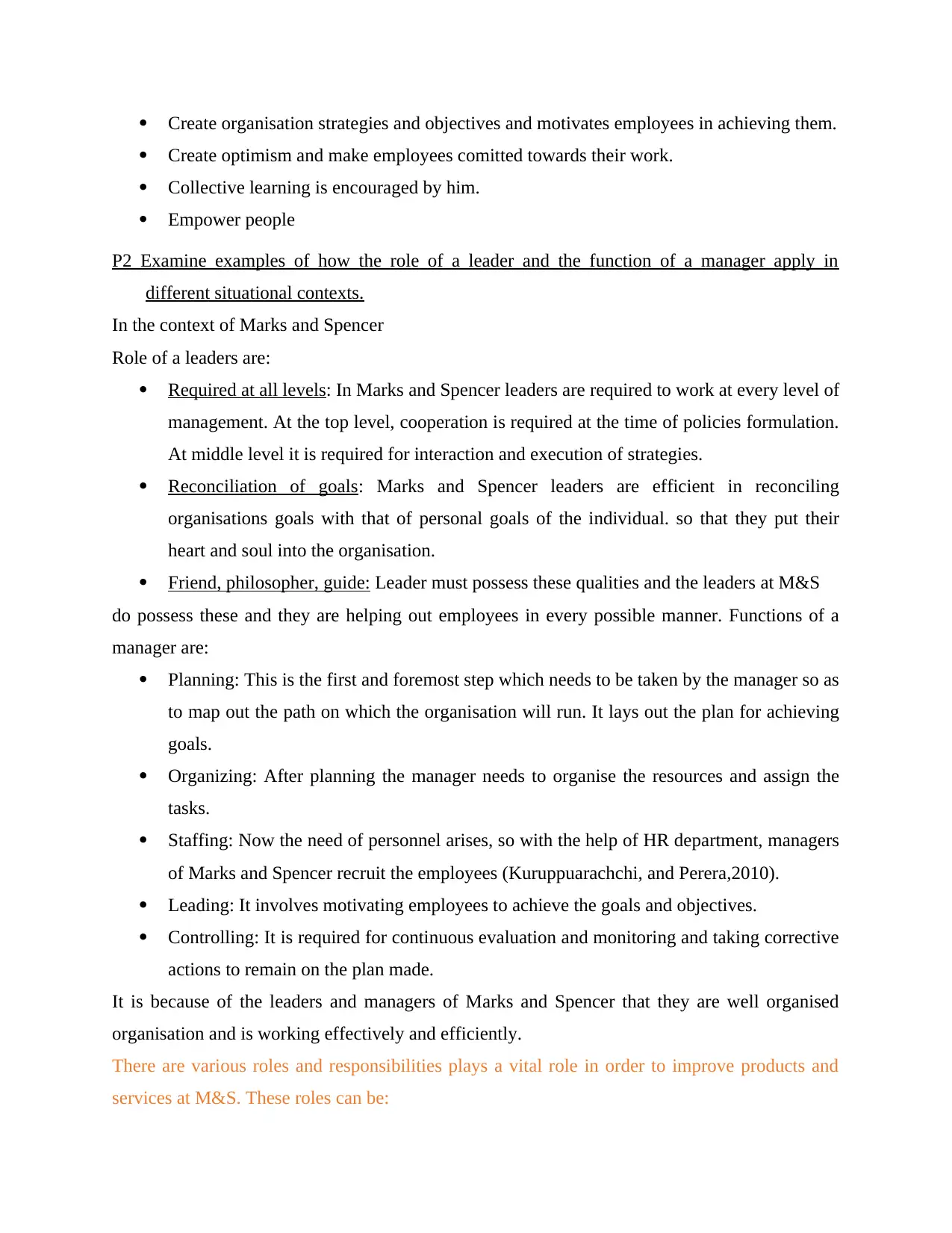
Create organisation strategies and objectives and motivates employees in achieving them.
Create optimism and make employees comitted towards their work.
Collective learning is encouraged by him.
Empower people
P2 Examine examples of how the role of a leader and the function of a manager apply in
different situational contexts.
In the context of Marks and Spencer
Role of a leaders are:
Required at all levels: In Marks and Spencer leaders are required to work at every level of
management. At the top level, cooperation is required at the time of policies formulation.
At middle level it is required for interaction and execution of strategies.
Reconciliation of goals: Marks and Spencer leaders are efficient in reconciling
organisations goals with that of personal goals of the individual. so that they put their
heart and soul into the organisation.
Friend, philosopher, guide: Leader must possess these qualities and the leaders at M&S
do possess these and they are helping out employees in every possible manner. Functions of a
manager are:
Planning: This is the first and foremost step which needs to be taken by the manager so as
to map out the path on which the organisation will run. It lays out the plan for achieving
goals.
Organizing: After planning the manager needs to organise the resources and assign the
tasks.
Staffing: Now the need of personnel arises, so with the help of HR department, managers
of Marks and Spencer recruit the employees (Kuruppuarachchi, and Perera,2010).
Leading: It involves motivating employees to achieve the goals and objectives.
Controlling: It is required for continuous evaluation and monitoring and taking corrective
actions to remain on the plan made.
It is because of the leaders and managers of Marks and Spencer that they are well organised
organisation and is working effectively and efficiently.
There are various roles and responsibilities plays a vital role in order to improve products and
services at M&S. These roles can be:
Create optimism and make employees comitted towards their work.
Collective learning is encouraged by him.
Empower people
P2 Examine examples of how the role of a leader and the function of a manager apply in
different situational contexts.
In the context of Marks and Spencer
Role of a leaders are:
Required at all levels: In Marks and Spencer leaders are required to work at every level of
management. At the top level, cooperation is required at the time of policies formulation.
At middle level it is required for interaction and execution of strategies.
Reconciliation of goals: Marks and Spencer leaders are efficient in reconciling
organisations goals with that of personal goals of the individual. so that they put their
heart and soul into the organisation.
Friend, philosopher, guide: Leader must possess these qualities and the leaders at M&S
do possess these and they are helping out employees in every possible manner. Functions of a
manager are:
Planning: This is the first and foremost step which needs to be taken by the manager so as
to map out the path on which the organisation will run. It lays out the plan for achieving
goals.
Organizing: After planning the manager needs to organise the resources and assign the
tasks.
Staffing: Now the need of personnel arises, so with the help of HR department, managers
of Marks and Spencer recruit the employees (Kuruppuarachchi, and Perera,2010).
Leading: It involves motivating employees to achieve the goals and objectives.
Controlling: It is required for continuous evaluation and monitoring and taking corrective
actions to remain on the plan made.
It is because of the leaders and managers of Marks and Spencer that they are well organised
organisation and is working effectively and efficiently.
There are various roles and responsibilities plays a vital role in order to improve products and
services at M&S. These roles can be:
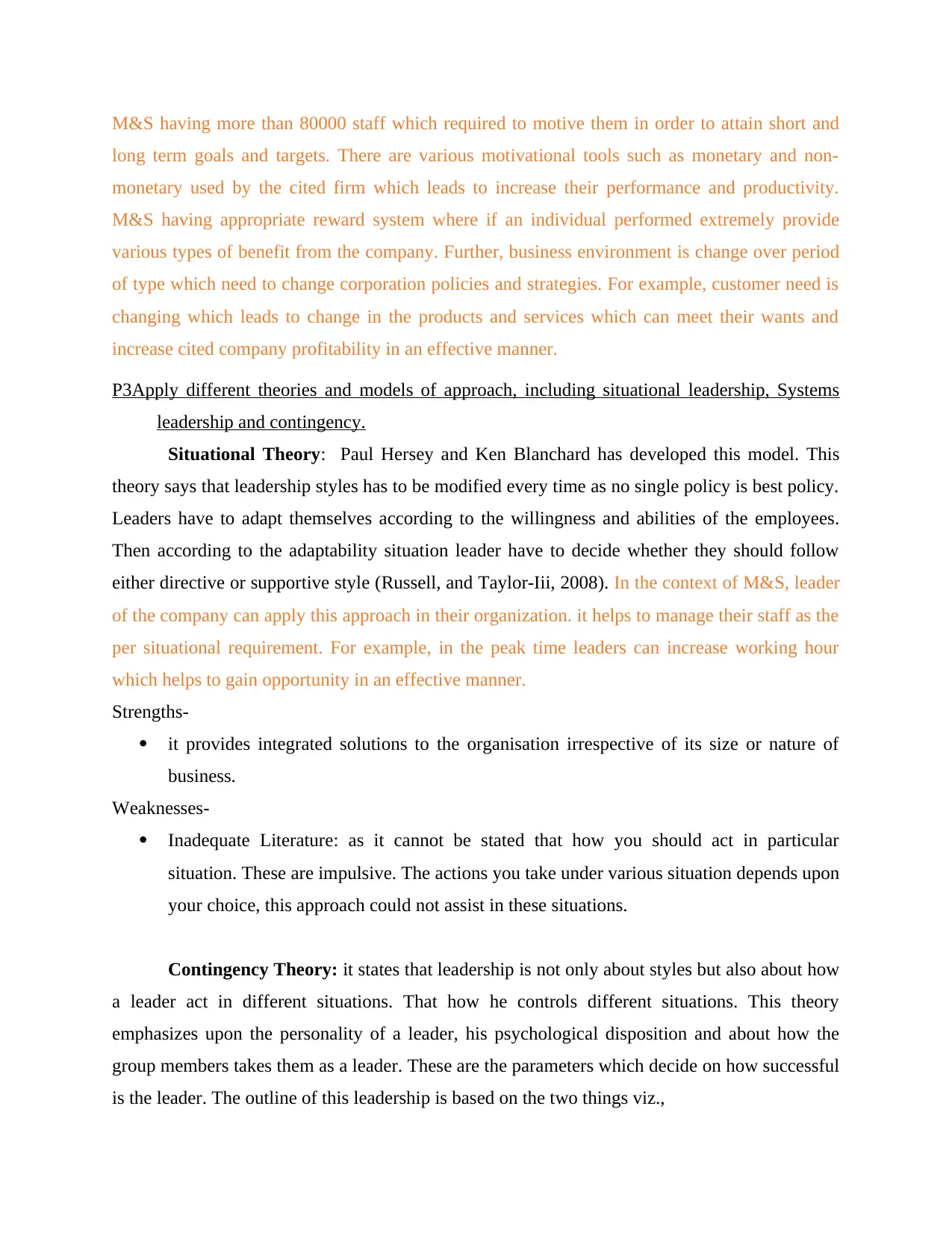
M&S having more than 80000 staff which required to motive them in order to attain short and
long term goals and targets. There are various motivational tools such as monetary and non-
monetary used by the cited firm which leads to increase their performance and productivity.
M&S having appropriate reward system where if an individual performed extremely provide
various types of benefit from the company. Further, business environment is change over period
of type which need to change corporation policies and strategies. For example, customer need is
changing which leads to change in the products and services which can meet their wants and
increase cited company profitability in an effective manner.
P3Apply different theories and models of approach, including situational leadership, Systems
leadership and contingency.
Situational Theory: Paul Hersey and Ken Blanchard has developed this model. This
theory says that leadership styles has to be modified every time as no single policy is best policy.
Leaders have to adapt themselves according to the willingness and abilities of the employees.
Then according to the adaptability situation leader have to decide whether they should follow
either directive or supportive style (Russell, and Taylor-Iii, 2008). In the context of M&S, leader
of the company can apply this approach in their organization. it helps to manage their staff as the
per situational requirement. For example, in the peak time leaders can increase working hour
which helps to gain opportunity in an effective manner.
Strengths-
it provides integrated solutions to the organisation irrespective of its size or nature of
business.
Weaknesses-
Inadequate Literature: as it cannot be stated that how you should act in particular
situation. These are impulsive. The actions you take under various situation depends upon
your choice, this approach could not assist in these situations.
Contingency Theory: it states that leadership is not only about styles but also about how
a leader act in different situations. That how he controls different situations. This theory
emphasizes upon the personality of a leader, his psychological disposition and about how the
group members takes them as a leader. These are the parameters which decide on how successful
is the leader. The outline of this leadership is based on the two things viz.,
long term goals and targets. There are various motivational tools such as monetary and non-
monetary used by the cited firm which leads to increase their performance and productivity.
M&S having appropriate reward system where if an individual performed extremely provide
various types of benefit from the company. Further, business environment is change over period
of type which need to change corporation policies and strategies. For example, customer need is
changing which leads to change in the products and services which can meet their wants and
increase cited company profitability in an effective manner.
P3Apply different theories and models of approach, including situational leadership, Systems
leadership and contingency.
Situational Theory: Paul Hersey and Ken Blanchard has developed this model. This
theory says that leadership styles has to be modified every time as no single policy is best policy.
Leaders have to adapt themselves according to the willingness and abilities of the employees.
Then according to the adaptability situation leader have to decide whether they should follow
either directive or supportive style (Russell, and Taylor-Iii, 2008). In the context of M&S, leader
of the company can apply this approach in their organization. it helps to manage their staff as the
per situational requirement. For example, in the peak time leaders can increase working hour
which helps to gain opportunity in an effective manner.
Strengths-
it provides integrated solutions to the organisation irrespective of its size or nature of
business.
Weaknesses-
Inadequate Literature: as it cannot be stated that how you should act in particular
situation. These are impulsive. The actions you take under various situation depends upon
your choice, this approach could not assist in these situations.
Contingency Theory: it states that leadership is not only about styles but also about how
a leader act in different situations. That how he controls different situations. This theory
emphasizes upon the personality of a leader, his psychological disposition and about how the
group members takes them as a leader. These are the parameters which decide on how successful
is the leader. The outline of this leadership is based on the two things viz.,
⊘ This is a preview!⊘
Do you want full access?
Subscribe today to unlock all pages.

Trusted by 1+ million students worldwide
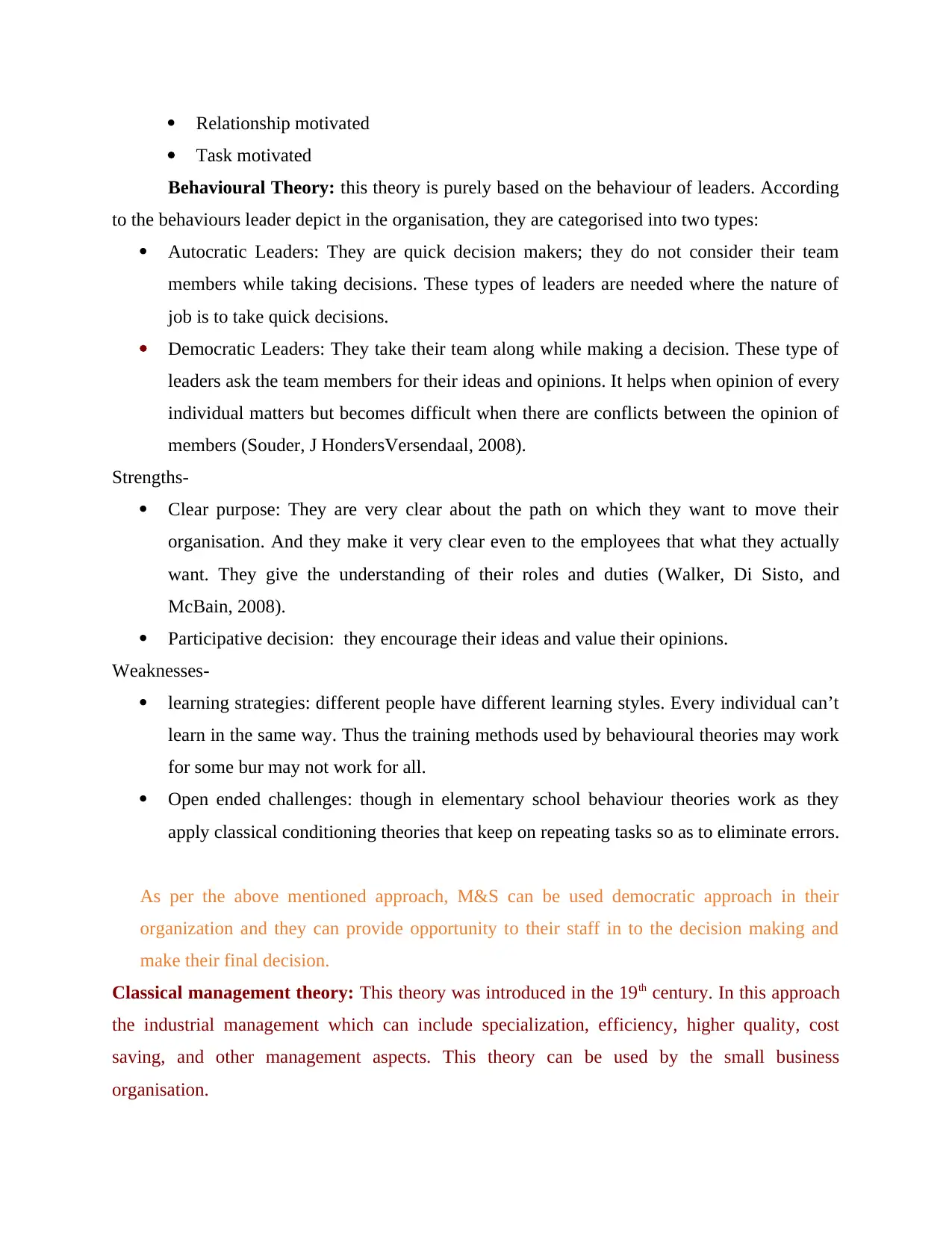
Relationship motivated
Task motivated
Behavioural Theory: this theory is purely based on the behaviour of leaders. According
to the behaviours leader depict in the organisation, they are categorised into two types:
Autocratic Leaders: They are quick decision makers; they do not consider their team
members while taking decisions. These types of leaders are needed where the nature of
job is to take quick decisions.
Democratic Leaders: They take their team along while making a decision. These type of
leaders ask the team members for their ideas and opinions. It helps when opinion of every
individual matters but becomes difficult when there are conflicts between the opinion of
members (Souder, J HondersVersendaal, 2008).
Strengths-
Clear purpose: They are very clear about the path on which they want to move their
organisation. And they make it very clear even to the employees that what they actually
want. They give the understanding of their roles and duties (Walker, Di Sisto, and
McBain, 2008).
Participative decision: they encourage their ideas and value their opinions.
Weaknesses-
learning strategies: different people have different learning styles. Every individual can’t
learn in the same way. Thus the training methods used by behavioural theories may work
for some bur may not work for all.
Open ended challenges: though in elementary school behaviour theories work as they
apply classical conditioning theories that keep on repeating tasks so as to eliminate errors.
As per the above mentioned approach, M&S can be used democratic approach in their
organization and they can provide opportunity to their staff in to the decision making and
make their final decision.
Classical management theory: This theory was introduced in the 19th century. In this approach
the industrial management which can include specialization, efficiency, higher quality, cost
saving, and other management aspects. This theory can be used by the small business
organisation.
Task motivated
Behavioural Theory: this theory is purely based on the behaviour of leaders. According
to the behaviours leader depict in the organisation, they are categorised into two types:
Autocratic Leaders: They are quick decision makers; they do not consider their team
members while taking decisions. These types of leaders are needed where the nature of
job is to take quick decisions.
Democratic Leaders: They take their team along while making a decision. These type of
leaders ask the team members for their ideas and opinions. It helps when opinion of every
individual matters but becomes difficult when there are conflicts between the opinion of
members (Souder, J HondersVersendaal, 2008).
Strengths-
Clear purpose: They are very clear about the path on which they want to move their
organisation. And they make it very clear even to the employees that what they actually
want. They give the understanding of their roles and duties (Walker, Di Sisto, and
McBain, 2008).
Participative decision: they encourage their ideas and value their opinions.
Weaknesses-
learning strategies: different people have different learning styles. Every individual can’t
learn in the same way. Thus the training methods used by behavioural theories may work
for some bur may not work for all.
Open ended challenges: though in elementary school behaviour theories work as they
apply classical conditioning theories that keep on repeating tasks so as to eliminate errors.
As per the above mentioned approach, M&S can be used democratic approach in their
organization and they can provide opportunity to their staff in to the decision making and
make their final decision.
Classical management theory: This theory was introduced in the 19th century. In this approach
the industrial management which can include specialization, efficiency, higher quality, cost
saving, and other management aspects. This theory can be used by the small business
organisation.
Paraphrase This Document
Need a fresh take? Get an instant paraphrase of this document with our AI Paraphraser
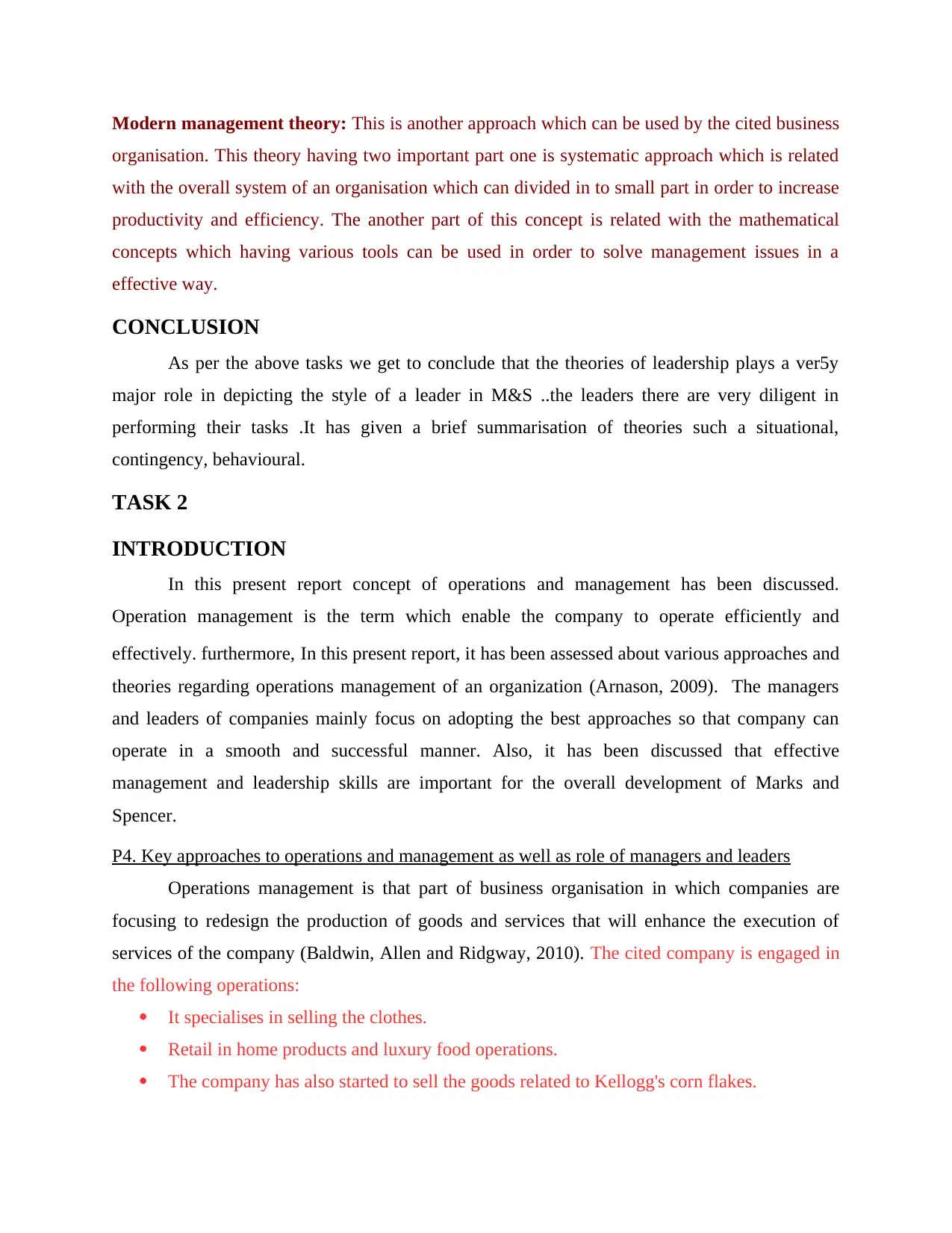
Modern management theory: This is another approach which can be used by the cited business
organisation. This theory having two important part one is systematic approach which is related
with the overall system of an organisation which can divided in to small part in order to increase
productivity and efficiency. The another part of this concept is related with the mathematical
concepts which having various tools can be used in order to solve management issues in a
effective way.
CONCLUSION
As per the above tasks we get to conclude that the theories of leadership plays a ver5y
major role in depicting the style of a leader in M&S ..the leaders there are very diligent in
performing their tasks .It has given a brief summarisation of theories such a situational,
contingency, behavioural.
TASK 2
INTRODUCTION
In this present report concept of operations and management has been discussed.
Operation management is the term which enable the company to operate efficiently and
effectively. furthermore, In this present report, it has been assessed about various approaches and
theories regarding operations management of an organization (Arnason, 2009). The managers
and leaders of companies mainly focus on adopting the best approaches so that company can
operate in a smooth and successful manner. Also, it has been discussed that effective
management and leadership skills are important for the overall development of Marks and
Spencer.
P4. Key approaches to operations and management as well as role of managers and leaders
Operations management is that part of business organisation in which companies are
focusing to redesign the production of goods and services that will enhance the execution of
services of the company (Baldwin, Allen and Ridgway, 2010). The cited company is engaged in
the following operations:
It specialises in selling the clothes.
Retail in home products and luxury food operations.
The company has also started to sell the goods related to Kellogg's corn flakes.
organisation. This theory having two important part one is systematic approach which is related
with the overall system of an organisation which can divided in to small part in order to increase
productivity and efficiency. The another part of this concept is related with the mathematical
concepts which having various tools can be used in order to solve management issues in a
effective way.
CONCLUSION
As per the above tasks we get to conclude that the theories of leadership plays a ver5y
major role in depicting the style of a leader in M&S ..the leaders there are very diligent in
performing their tasks .It has given a brief summarisation of theories such a situational,
contingency, behavioural.
TASK 2
INTRODUCTION
In this present report concept of operations and management has been discussed.
Operation management is the term which enable the company to operate efficiently and
effectively. furthermore, In this present report, it has been assessed about various approaches and
theories regarding operations management of an organization (Arnason, 2009). The managers
and leaders of companies mainly focus on adopting the best approaches so that company can
operate in a smooth and successful manner. Also, it has been discussed that effective
management and leadership skills are important for the overall development of Marks and
Spencer.
P4. Key approaches to operations and management as well as role of managers and leaders
Operations management is that part of business organisation in which companies are
focusing to redesign the production of goods and services that will enhance the execution of
services of the company (Baldwin, Allen and Ridgway, 2010). The cited company is engaged in
the following operations:
It specialises in selling the clothes.
Retail in home products and luxury food operations.
The company has also started to sell the goods related to Kellogg's corn flakes.
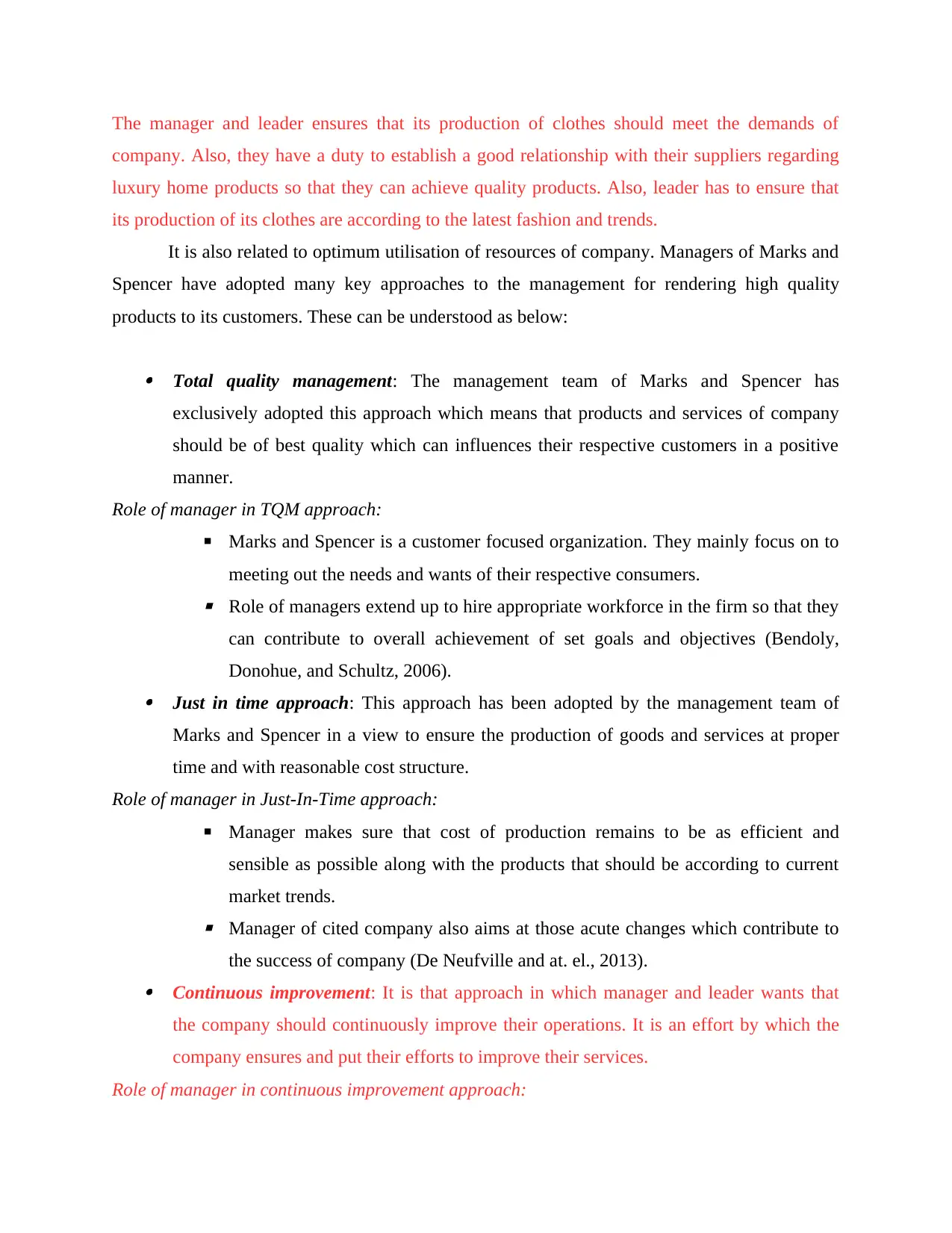
The manager and leader ensures that its production of clothes should meet the demands of
company. Also, they have a duty to establish a good relationship with their suppliers regarding
luxury home products so that they can achieve quality products. Also, leader has to ensure that
its production of its clothes are according to the latest fashion and trends.
It is also related to optimum utilisation of resources of company. Managers of Marks and
Spencer have adopted many key approaches to the management for rendering high quality
products to its customers. These can be understood as below:
Total quality management: The management team of Marks and Spencer has
exclusively adopted this approach which means that products and services of company
should be of best quality which can influences their respective customers in a positive
manner.
Role of manager in TQM approach:
▪ Marks and Spencer is a customer focused organization. They mainly focus on to
meeting out the needs and wants of their respective consumers.
▪ Role of managers extend up to hire appropriate workforce in the firm so that they
can contribute to overall achievement of set goals and objectives (Bendoly,
Donohue, and Schultz, 2006). Just in time approach: This approach has been adopted by the management team of
Marks and Spencer in a view to ensure the production of goods and services at proper
time and with reasonable cost structure.
Role of manager in Just-In-Time approach:
▪ Manager makes sure that cost of production remains to be as efficient and
sensible as possible along with the products that should be according to current
market trends.
▪ Manager of cited company also aims at those acute changes which contribute to
the success of company (De Neufville and at. el., 2013). Continuous improvement: It is that approach in which manager and leader wants that
the company should continuously improve their operations. It is an effort by which the
company ensures and put their efforts to improve their services.
Role of manager in continuous improvement approach:
company. Also, they have a duty to establish a good relationship with their suppliers regarding
luxury home products so that they can achieve quality products. Also, leader has to ensure that
its production of its clothes are according to the latest fashion and trends.
It is also related to optimum utilisation of resources of company. Managers of Marks and
Spencer have adopted many key approaches to the management for rendering high quality
products to its customers. These can be understood as below:
Total quality management: The management team of Marks and Spencer has
exclusively adopted this approach which means that products and services of company
should be of best quality which can influences their respective customers in a positive
manner.
Role of manager in TQM approach:
▪ Marks and Spencer is a customer focused organization. They mainly focus on to
meeting out the needs and wants of their respective consumers.
▪ Role of managers extend up to hire appropriate workforce in the firm so that they
can contribute to overall achievement of set goals and objectives (Bendoly,
Donohue, and Schultz, 2006). Just in time approach: This approach has been adopted by the management team of
Marks and Spencer in a view to ensure the production of goods and services at proper
time and with reasonable cost structure.
Role of manager in Just-In-Time approach:
▪ Manager makes sure that cost of production remains to be as efficient and
sensible as possible along with the products that should be according to current
market trends.
▪ Manager of cited company also aims at those acute changes which contribute to
the success of company (De Neufville and at. el., 2013). Continuous improvement: It is that approach in which manager and leader wants that
the company should continuously improve their operations. It is an effort by which the
company ensures and put their efforts to improve their services.
Role of manager in continuous improvement approach:
⊘ This is a preview!⊘
Do you want full access?
Subscribe today to unlock all pages.

Trusted by 1+ million students worldwide
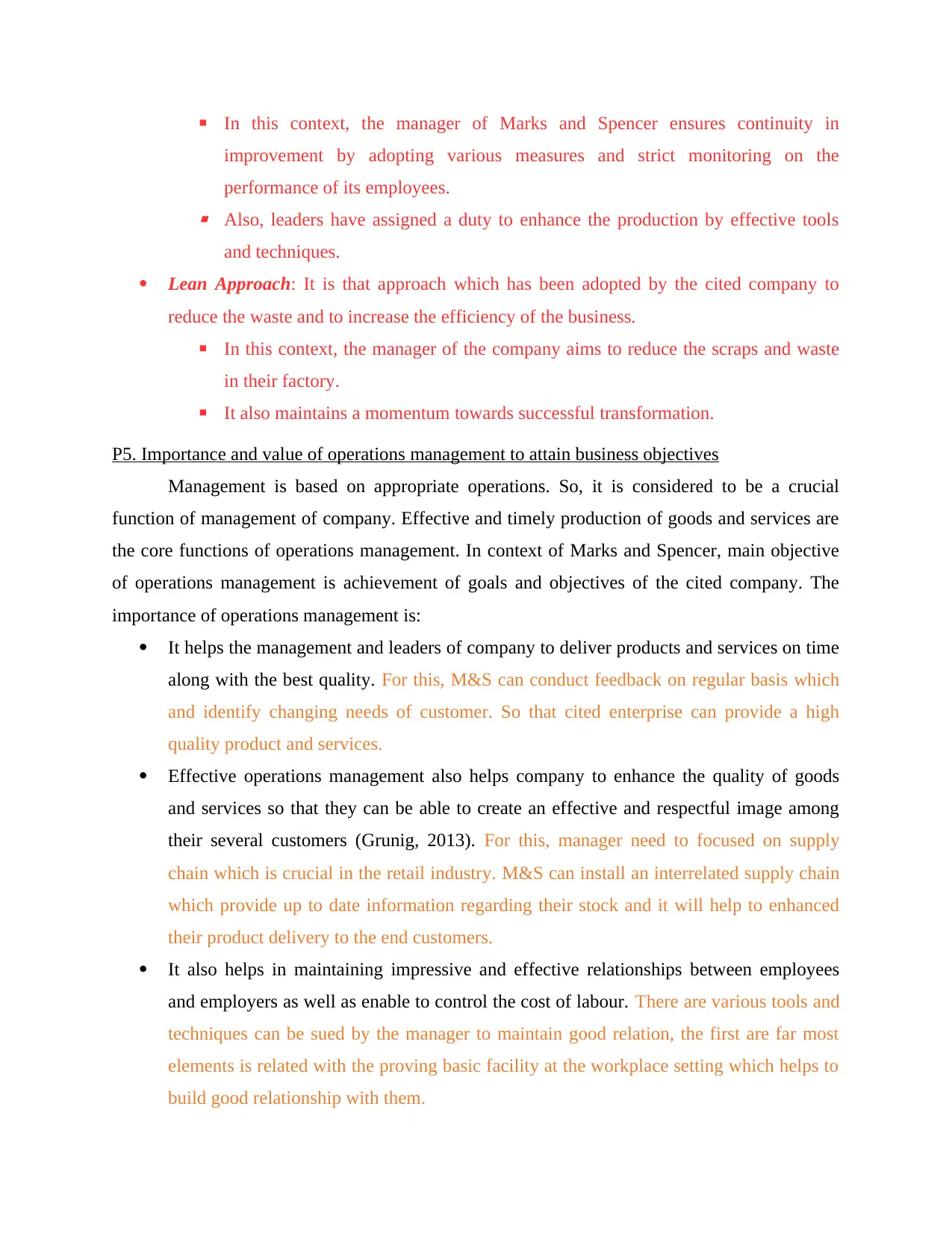
▪ In this context, the manager of Marks and Spencer ensures continuity in
improvement by adopting various measures and strict monitoring on the
performance of its employees.
▪ Also, leaders have assigned a duty to enhance the production by effective tools
and techniques.
Lean Approach: It is that approach which has been adopted by the cited company to
reduce the waste and to increase the efficiency of the business.
▪ In this context, the manager of the company aims to reduce the scraps and waste
in their factory.
▪ It also maintains a momentum towards successful transformation.
P5. Importance and value of operations management to attain business objectives
Management is based on appropriate operations. So, it is considered to be a crucial
function of management of company. Effective and timely production of goods and services are
the core functions of operations management. In context of Marks and Spencer, main objective
of operations management is achievement of goals and objectives of the cited company. The
importance of operations management is:
It helps the management and leaders of company to deliver products and services on time
along with the best quality. For this, M&S can conduct feedback on regular basis which
and identify changing needs of customer. So that cited enterprise can provide a high
quality product and services.
Effective operations management also helps company to enhance the quality of goods
and services so that they can be able to create an effective and respectful image among
their several customers (Grunig, 2013). For this, manager need to focused on supply
chain which is crucial in the retail industry. M&S can install an interrelated supply chain
which provide up to date information regarding their stock and it will help to enhanced
their product delivery to the end customers.
It also helps in maintaining impressive and effective relationships between employees
and employers as well as enable to control the cost of labour. There are various tools and
techniques can be sued by the manager to maintain good relation, the first are far most
elements is related with the proving basic facility at the workplace setting which helps to
build good relationship with them.
improvement by adopting various measures and strict monitoring on the
performance of its employees.
▪ Also, leaders have assigned a duty to enhance the production by effective tools
and techniques.
Lean Approach: It is that approach which has been adopted by the cited company to
reduce the waste and to increase the efficiency of the business.
▪ In this context, the manager of the company aims to reduce the scraps and waste
in their factory.
▪ It also maintains a momentum towards successful transformation.
P5. Importance and value of operations management to attain business objectives
Management is based on appropriate operations. So, it is considered to be a crucial
function of management of company. Effective and timely production of goods and services are
the core functions of operations management. In context of Marks and Spencer, main objective
of operations management is achievement of goals and objectives of the cited company. The
importance of operations management is:
It helps the management and leaders of company to deliver products and services on time
along with the best quality. For this, M&S can conduct feedback on regular basis which
and identify changing needs of customer. So that cited enterprise can provide a high
quality product and services.
Effective operations management also helps company to enhance the quality of goods
and services so that they can be able to create an effective and respectful image among
their several customers (Grunig, 2013). For this, manager need to focused on supply
chain which is crucial in the retail industry. M&S can install an interrelated supply chain
which provide up to date information regarding their stock and it will help to enhanced
their product delivery to the end customers.
It also helps in maintaining impressive and effective relationships between employees
and employers as well as enable to control the cost of labour. There are various tools and
techniques can be sued by the manager to maintain good relation, the first are far most
elements is related with the proving basic facility at the workplace setting which helps to
build good relationship with them.
Paraphrase This Document
Need a fresh take? Get an instant paraphrase of this document with our AI Paraphraser
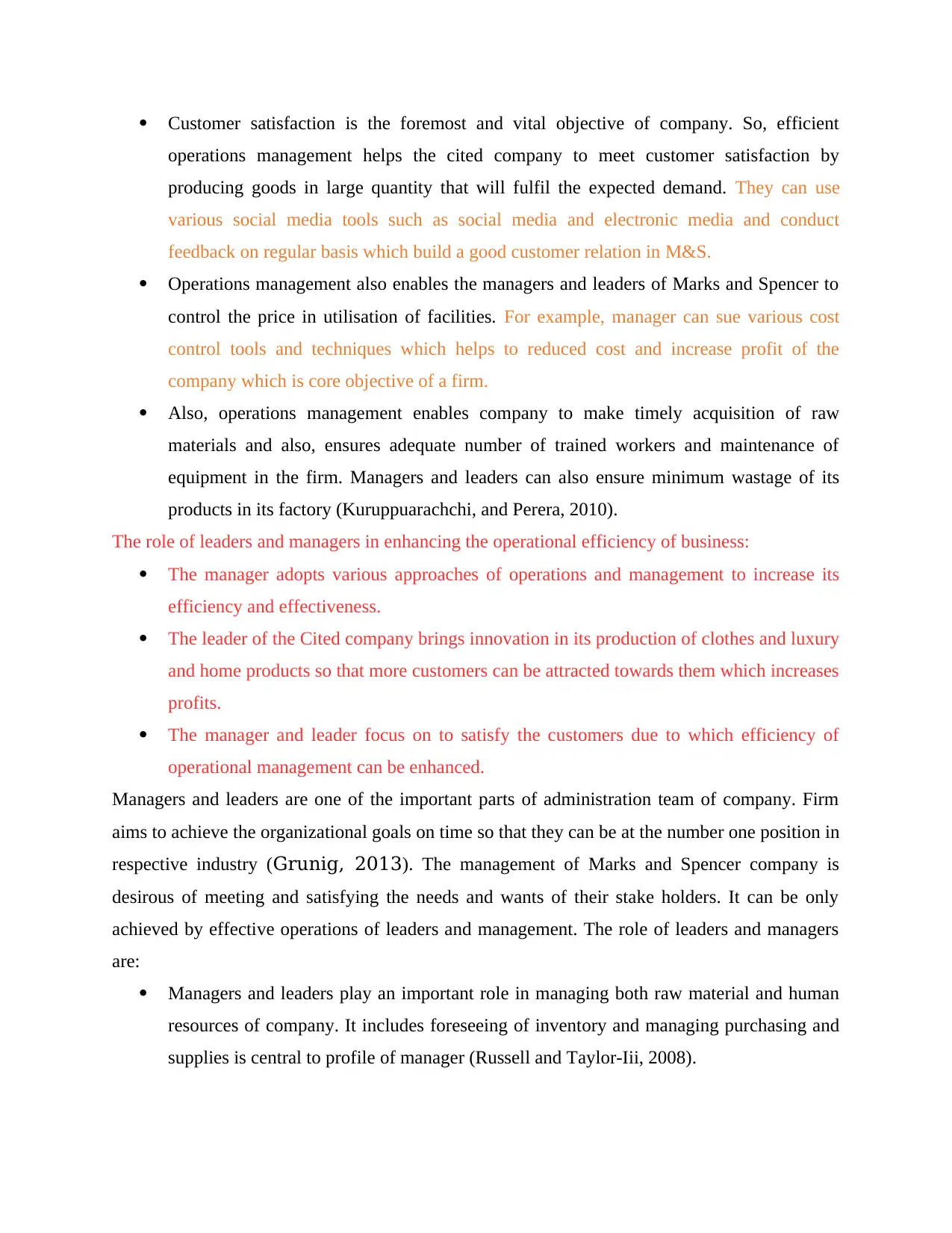
Customer satisfaction is the foremost and vital objective of company. So, efficient
operations management helps the cited company to meet customer satisfaction by
producing goods in large quantity that will fulfil the expected demand. They can use
various social media tools such as social media and electronic media and conduct
feedback on regular basis which build a good customer relation in M&S.
Operations management also enables the managers and leaders of Marks and Spencer to
control the price in utilisation of facilities. For example, manager can sue various cost
control tools and techniques which helps to reduced cost and increase profit of the
company which is core objective of a firm.
Also, operations management enables company to make timely acquisition of raw
materials and also, ensures adequate number of trained workers and maintenance of
equipment in the firm. Managers and leaders can also ensure minimum wastage of its
products in its factory (Kuruppuarachchi, and Perera, 2010).
The role of leaders and managers in enhancing the operational efficiency of business:
The manager adopts various approaches of operations and management to increase its
efficiency and effectiveness.
The leader of the Cited company brings innovation in its production of clothes and luxury
and home products so that more customers can be attracted towards them which increases
profits.
The manager and leader focus on to satisfy the customers due to which efficiency of
operational management can be enhanced.
Managers and leaders are one of the important parts of administration team of company. Firm
aims to achieve the organizational goals on time so that they can be at the number one position in
respective industry (Grunig, 2013). The management of Marks and Spencer company is
desirous of meeting and satisfying the needs and wants of their stake holders. It can be only
achieved by effective operations of leaders and management. The role of leaders and managers
are:
Managers and leaders play an important role in managing both raw material and human
resources of company. It includes foreseeing of inventory and managing purchasing and
supplies is central to profile of manager (Russell and Taylor-Iii, 2008).
operations management helps the cited company to meet customer satisfaction by
producing goods in large quantity that will fulfil the expected demand. They can use
various social media tools such as social media and electronic media and conduct
feedback on regular basis which build a good customer relation in M&S.
Operations management also enables the managers and leaders of Marks and Spencer to
control the price in utilisation of facilities. For example, manager can sue various cost
control tools and techniques which helps to reduced cost and increase profit of the
company which is core objective of a firm.
Also, operations management enables company to make timely acquisition of raw
materials and also, ensures adequate number of trained workers and maintenance of
equipment in the firm. Managers and leaders can also ensure minimum wastage of its
products in its factory (Kuruppuarachchi, and Perera, 2010).
The role of leaders and managers in enhancing the operational efficiency of business:
The manager adopts various approaches of operations and management to increase its
efficiency and effectiveness.
The leader of the Cited company brings innovation in its production of clothes and luxury
and home products so that more customers can be attracted towards them which increases
profits.
The manager and leader focus on to satisfy the customers due to which efficiency of
operational management can be enhanced.
Managers and leaders are one of the important parts of administration team of company. Firm
aims to achieve the organizational goals on time so that they can be at the number one position in
respective industry (Grunig, 2013). The management of Marks and Spencer company is
desirous of meeting and satisfying the needs and wants of their stake holders. It can be only
achieved by effective operations of leaders and management. The role of leaders and managers
are:
Managers and leaders play an important role in managing both raw material and human
resources of company. It includes foreseeing of inventory and managing purchasing and
supplies is central to profile of manager (Russell and Taylor-Iii, 2008).
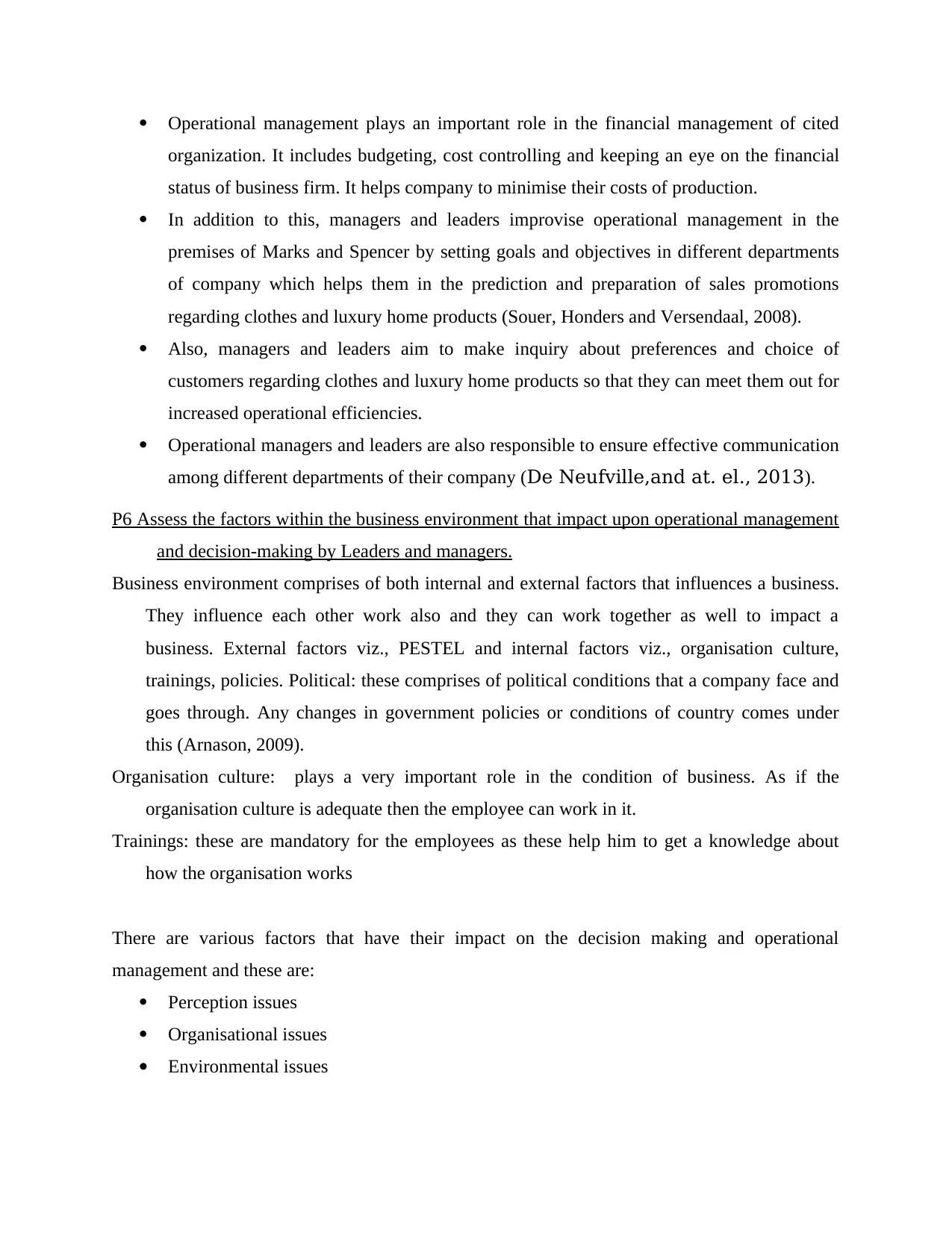
Operational management plays an important role in the financial management of cited
organization. It includes budgeting, cost controlling and keeping an eye on the financial
status of business firm. It helps company to minimise their costs of production.
In addition to this, managers and leaders improvise operational management in the
premises of Marks and Spencer by setting goals and objectives in different departments
of company which helps them in the prediction and preparation of sales promotions
regarding clothes and luxury home products (Souer, Honders and Versendaal, 2008).
Also, managers and leaders aim to make inquiry about preferences and choice of
customers regarding clothes and luxury home products so that they can meet them out for
increased operational efficiencies.
Operational managers and leaders are also responsible to ensure effective communication
among different departments of their company (De Neufville,and at. el., 2013).
P6 Assess the factors within the business environment that impact upon operational management
and decision-making by Leaders and managers.
Business environment comprises of both internal and external factors that influences a business.
They influence each other work also and they can work together as well to impact a
business. External factors viz., PESTEL and internal factors viz., organisation culture,
trainings, policies. Political: these comprises of political conditions that a company face and
goes through. Any changes in government policies or conditions of country comes under
this (Arnason, 2009).
Organisation culture: plays a very important role in the condition of business. As if the
organisation culture is adequate then the employee can work in it.
Trainings: these are mandatory for the employees as these help him to get a knowledge about
how the organisation works
There are various factors that have their impact on the decision making and operational
management and these are:
Perception issues
Organisational issues
Environmental issues
organization. It includes budgeting, cost controlling and keeping an eye on the financial
status of business firm. It helps company to minimise their costs of production.
In addition to this, managers and leaders improvise operational management in the
premises of Marks and Spencer by setting goals and objectives in different departments
of company which helps them in the prediction and preparation of sales promotions
regarding clothes and luxury home products (Souer, Honders and Versendaal, 2008).
Also, managers and leaders aim to make inquiry about preferences and choice of
customers regarding clothes and luxury home products so that they can meet them out for
increased operational efficiencies.
Operational managers and leaders are also responsible to ensure effective communication
among different departments of their company (De Neufville,and at. el., 2013).
P6 Assess the factors within the business environment that impact upon operational management
and decision-making by Leaders and managers.
Business environment comprises of both internal and external factors that influences a business.
They influence each other work also and they can work together as well to impact a
business. External factors viz., PESTEL and internal factors viz., organisation culture,
trainings, policies. Political: these comprises of political conditions that a company face and
goes through. Any changes in government policies or conditions of country comes under
this (Arnason, 2009).
Organisation culture: plays a very important role in the condition of business. As if the
organisation culture is adequate then the employee can work in it.
Trainings: these are mandatory for the employees as these help him to get a knowledge about
how the organisation works
There are various factors that have their impact on the decision making and operational
management and these are:
Perception issues
Organisational issues
Environmental issues
⊘ This is a preview!⊘
Do you want full access?
Subscribe today to unlock all pages.

Trusted by 1+ million students worldwide
1 out of 18
Related Documents
Your All-in-One AI-Powered Toolkit for Academic Success.
+13062052269
info@desklib.com
Available 24*7 on WhatsApp / Email
![[object Object]](/_next/static/media/star-bottom.7253800d.svg)
Unlock your academic potential
Copyright © 2020–2025 A2Z Services. All Rights Reserved. Developed and managed by ZUCOL.





